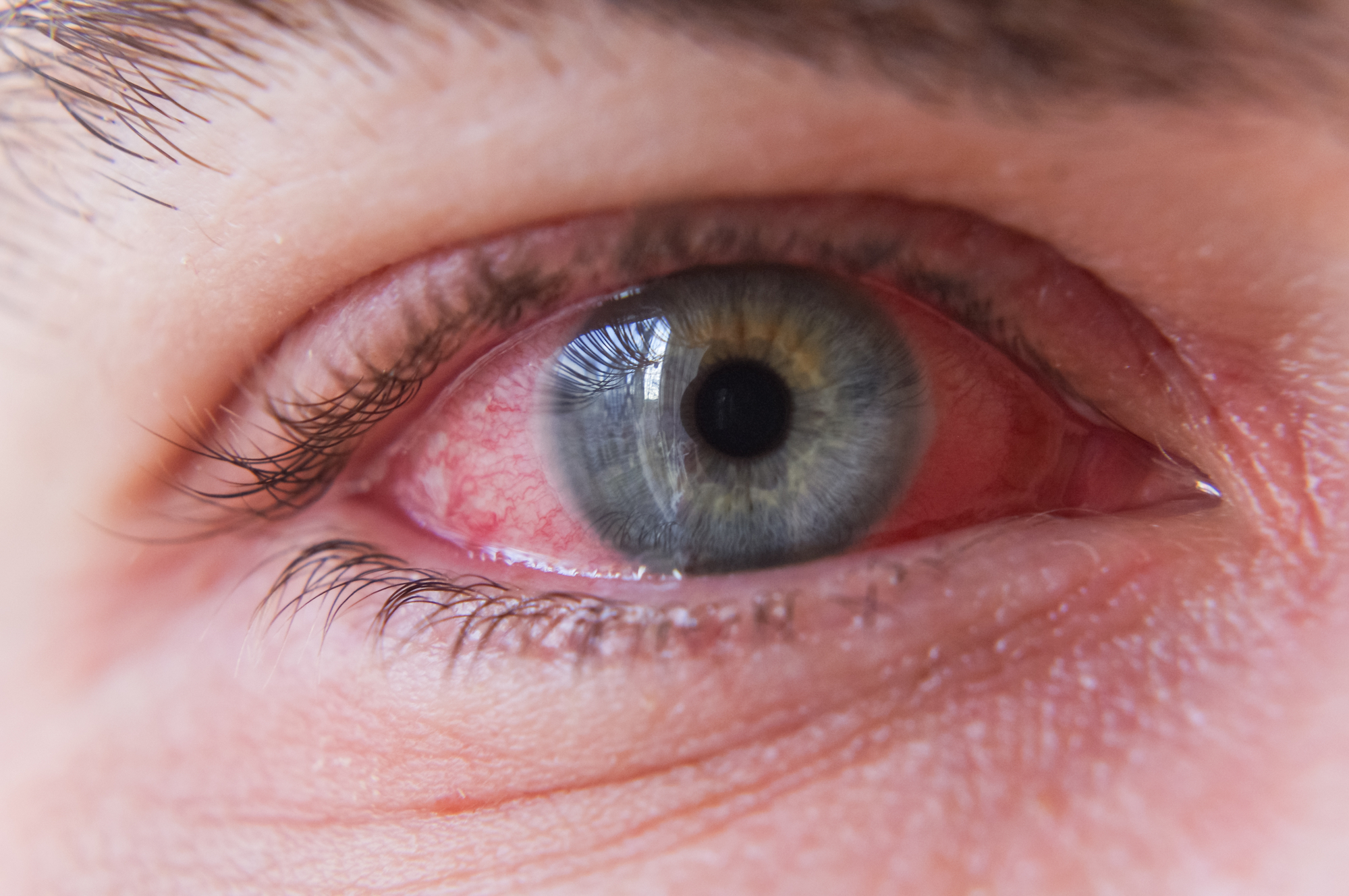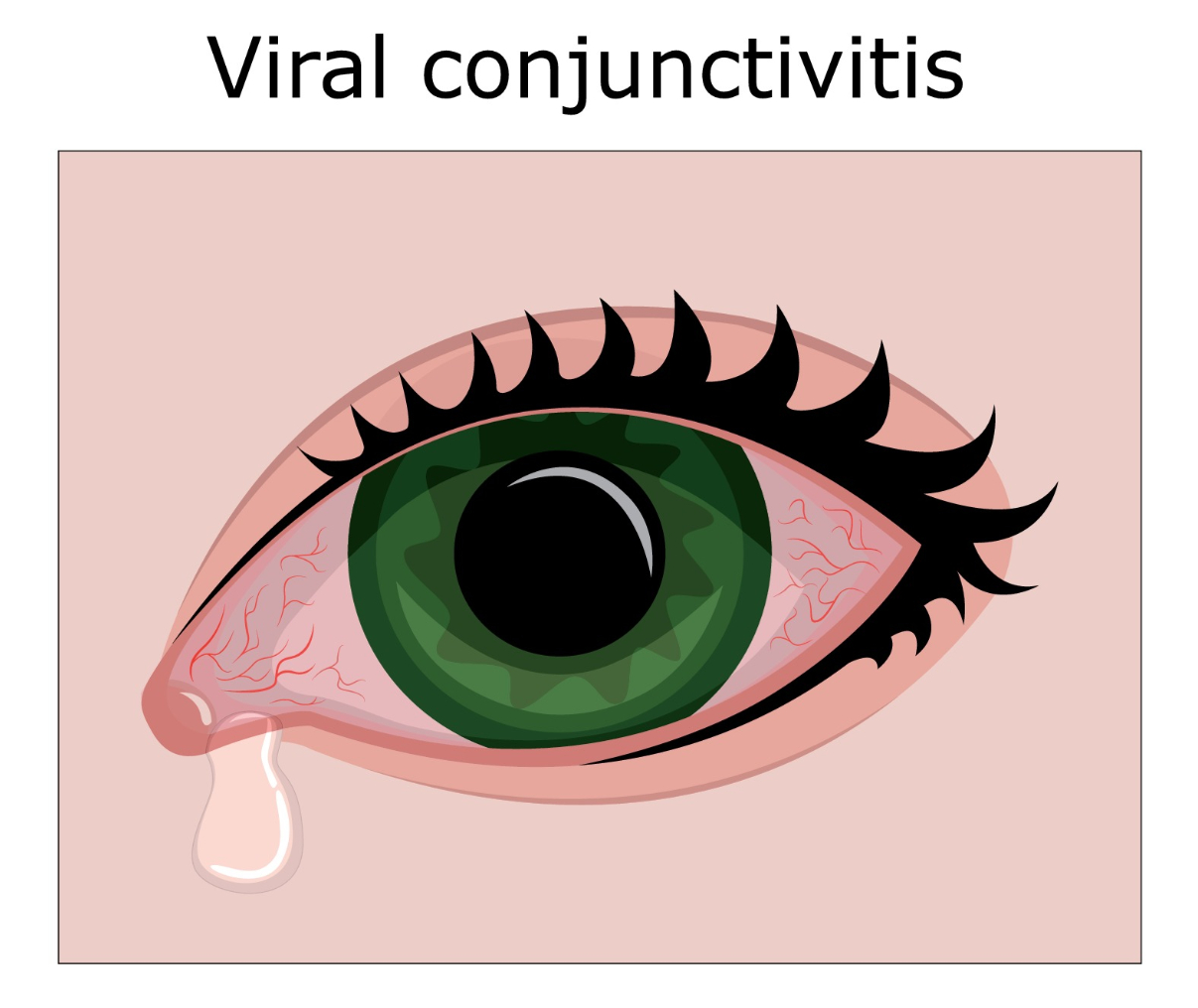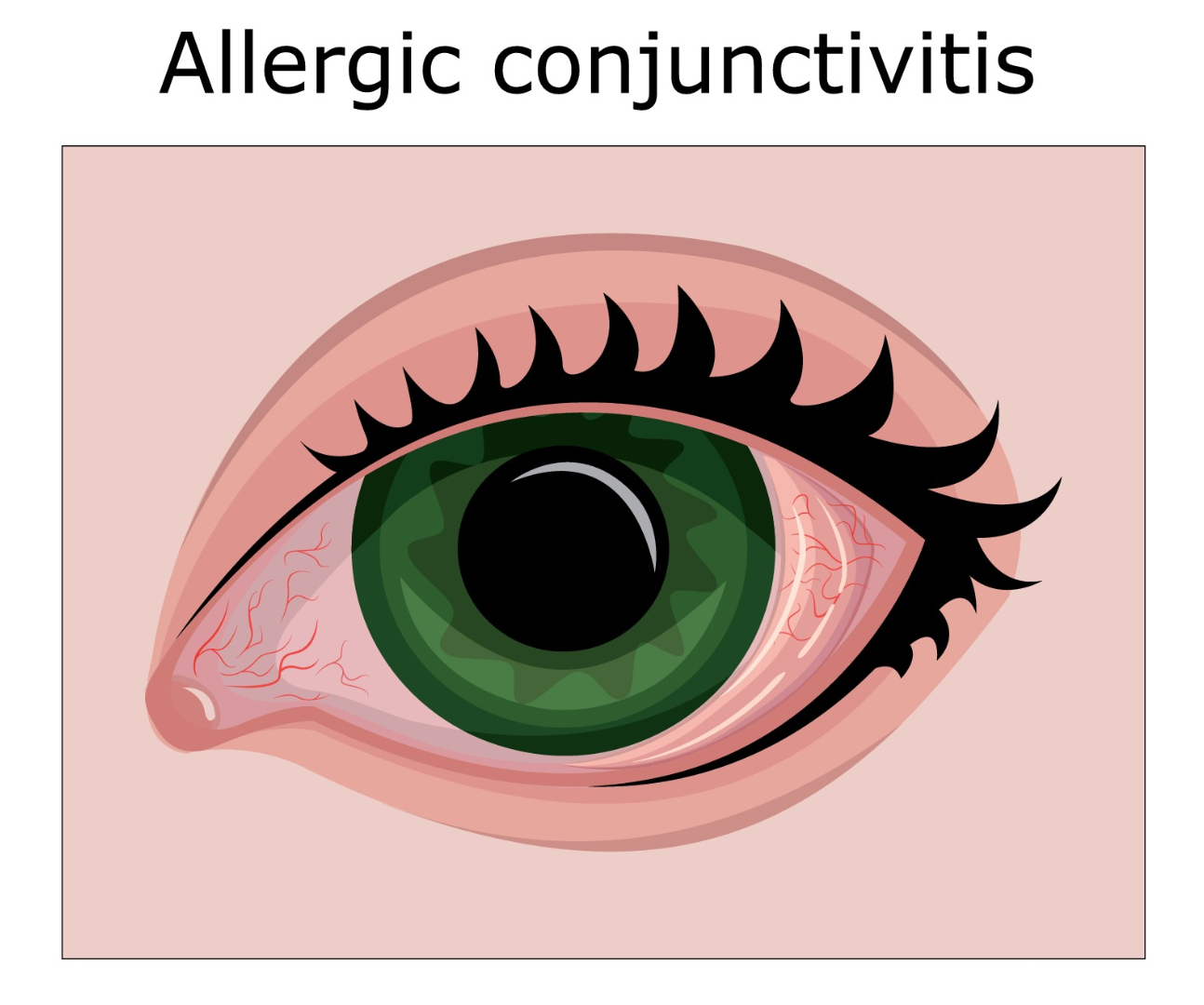Updated on April 30, 2025
Pink Eye (Conjunctivitis)

Vision Center is funded by our readers. We may earn commissions if you purchase something via one of our links.
What Is Pink Eye?
Conjunctivitis is an inflammation of the conjunctiva. The conjunctiva is the thin layer of tissue covering the whites of your eye and lining the inner portion of your eyelids.

Most people consider pink eye a contagious viral infection, but not all forms of conjunctivitis are infectious. For example, a foreign body in the eye can also cause irritation and inflammation.
Common Symptoms
Viral, bacterial, and allergic conjunctivitis often cause similar symptoms, but some key features can help you distinguish one from the other.

Viral
You may notice burning, light sensitivity, redness, clear discharge, and swollen eyelids. You may have swollen and tender preauricular lymph nodes in front of your ears.
An indication you may have viral conjunctivitis is if you had a cold recently or were exposed to someone sick. This conjunctivitis often starts in one eye and spreads to the other.
While pink eye conjunctivitis doesn’t affect your sight, you may experience blurred vision.5

Bacterial
Bacterial conjunctivitis symptoms include redness, pain, burning, and swollen eyelids. One way to differentiate it from viral conjunctivitis is that it also causes sticky pus to develop in the eye. This can manifest as a yellow, green, or white discharge.
Generally, bacterial conjunctivitis does not cause swollen preauricular lymph nodes. Although it typically occurs in one eye, the other eye can become infected.

Allergic
A primary distinction between allergic and viral or bacterial conjunctivitis is that allergies tend to cause itching. Other symptoms include redness, tearing, light sensitivity, and swollen eyelids.
Some people also notice white, stringy discharge, but most have a clear, watery discharge.
Allergic conjunctivitis usually occurs in both eyes. You may also have symptoms of sinus congestion, sneezing, or a runny nose.
Is Conjunctivitis Contagious?
Viral conjunctivitis is highly contagious. Adenovirus spreads through close personal contact, through the air via respiratory droplets, or by touching contaminated surfaces.
Bacterial conjunctivitis spreads via personal contact, touching contaminated surfaces, and respiratory droplets.
In some cases, changes to your eye’s normal bacterial flora can also cause pink eye. Allergic pink eye is not contagious.
Conjunctivitis Causes
These are the most frequent causes of conjunctivitis:
Viral
Most types of viral conjunctivitis are associated with the adenovirus. The viral infection also causes illnesses like the common cold, bronchitis, pneumonia, and gastrointestinal upset. It’s highly contagious.
Can HSV Cause Conjunctivitis?
The herpes simplex virus, or HSV, can also cause conjunctivitis.6 This can happen through eye contact with infected oral or genital secretions. You may experience severe pain, redness, or bright light sensitivity in the pink eye.
Bacterial
Bacterial conjunctivitis is not as common as viral conjunctivitis but is also very contagious. However, this is the most frequent cause of conjunctivitis in children under three.
This type of conjunctivitis can spread through:4
- Hand-to-eye contact
- Eye contact with contaminated objects, such as contact lenses
- Sexual encounters with an eye to genital contact
- Mother to baby
Allergic
This form of conjunctivitis occurs when you are exposed to an allergen such as dust, pollen, or pet dander. Depending on the source of your allergy, allergic conjunctivitis may last for extended periods (chronic) or short periods (acute).
Viruses cause around 80 percent of acute conjunctivitis cases. It isn't caused by eye disease.
Does Wearing Contact Lenses Cause Conjunctivitis?
No, wearing contact lenses won’t cause conjunctivitis.
However, cleaning your contact lenses improperly can cause irritation and other problems. Always clean your contact lenses properly and regularly to prevent an infected eye.
How Long Is Pink Eye Contagious?
It is best to avoid close contact with others until symptoms subside or 24 hours after antibiotic treatment for bacterial conjunctivitis.7
While allergic conjunctivitis is not contagious, viral and bacterial pink eye are highly contagious. Avoiding close contact with other people will prevent its spread.
In the meantime, be careful not to spread the infection to others. Avoid going to work or school and contaminating surfaces someone else may touch. Remove your contact lenses immediately, and only use your eyeglasses.
How Long Does Pink Eye Last?
The type and severity of conjunctivitis affect how long it will last. Recovery could be longer if it is related to another illness, such as the common cold, ear infection, or upper respiratory infection.
Healthcare professionals estimate recovery time for the different types of pink eye as follows:
- Bacterial conjunctivitis. Typically improves 24 hours after starting antibiotic eye drops. If left untreated, it can take two weeks to go away completely.
- Viral conjunctivitis. Usually mild and will resolve within 7 to 14 days. However, more severe cases could take up to 3 weeks to subside.
- Allergic conjunctivitis. Typically resolves after removing the environmental trigger.
Diagnosis of Pink Eye
If you have conjunctivitis, especially contagious, consult your eye doctor.
Your eye doctor can examine your eyes to determine what kind of conjunctivitis you have. Your symptoms and health history will help them make the diagnosis.
During the exam, they use an instrument called a slit-lamp to view your eyes under magnification.
A yellow-colored eye drop called fluorescein helps the doctor look for signs of eye irritation or injury while examining your eyes in the slit-lamp. They may also check your preauricular lymph nodes for any swelling.
Prevention Tips
Practicing good hygiene is the best way to prevent infectious types of conjunctivitis, including viral and bacterial.
Here are some prevention tips for viral and bacterial conjunctivitis:
- Wear a face mask to protect yourself from respiratory droplet exposure if you are around someone ill.
- Don’t touch your eyes before washing your hands. If you must, use a tissue.
- Wash your hands with soap frequently or use hand sanitizer if you cannot.
- Regularly wash pillowcases, towels, eye masks, and anything else that touches your face.
- Don’t use old or contaminated contact lenses, contact lens cases, eye makeup, or any other products that come in contact with your eyes.
- Don’t wear contact lenses if you have viral or bacterial conjunctivitis.
- Frequently sanitize high-touch surfaces such as doorknobs, sinks, handles, phones, and computer keyboards.
- If you wear extended-wear lenses, remember to remove and clean them regularly.
- Don’t attend work or school until your conjunctivitis resolves to avoid infecting others.
Here are tips to reduce your risk of allergic conjunctivitis:
- The best form of prevention is to avoid potential allergens.
- If you are unsure what you are allergic to, consult your doctor for allergy testing.
- Wear a face mask when exposed to dust, pollen, pollutants, or other potential irritants.
- Many people have dust mite allergies. Wash your bedding frequently and use a mattress protector to reduce exposure to dust mites.
- Vacuum carpets and furniture regularly.
- Use an air purifier to help remove allergens from the air.
- If you have pet allergies, bathe your pet regularly, clean blankets or other items your pet touches, do not allow pets on the bed, and wash your hands after touching your pets.
- Stay indoors as much as possible when seasonal allergies are at a peak. Wearing glasses or sunglasses outdoors helps prevent allergens from getting into your eyes.
Treatment Options
Many cases of conjunctivitis are self-limiting, which means the condition resolves on its own without treatment. However, it is best to consult your eye doctor for a diagnosis and the appropriate treatment plan.
Viral Conjunctivitis Treatment
Treatment is usually not required for viral conjunctivitis.
Unfortunately, there is no treatment to shorten the duration of the infection. Only therapy focused on symptomatic relief is available.
You can use cool compresses and lubricating drops if your eyes feel irritated. Depending on the severity of the inflammation, your doctor may prescribe anti-inflammatory eye drops.
Bacterial Conjunctivitis Treatment
Most eye doctors prescribe antibiotic eye drops or ointment for bacterial conjunctivitis. These help reduce the duration to only a few days.
Keeping the eye area clean and free of discharge is also ideal. The eye doctor may prescribe oral antibiotics if the infection is severe, especially in children.
Allergic Conjunctivitis Treatment
Non-medicated therapies for allergic conjunctivitis include cool compresses and lubricating drops. Oral allergy medication may also provide relief.
If your allergies persist, the eye doctor can prescribe anti-inflammatory or antihistamine eye drops.
Avoiding the source of your allergies is the best way to alleviate allergic conjunctivitis. You can also use artificial tears to relieve symptoms.
Summary
Pink eye conjunctivitis is a common infection that affects the eyes. A virus, bacteria, or an allergy can cause it.
Always practice good hygiene habits and avoid potential allergens to prevent conjunctivitis. Treatment options vary for this condition, but always consult your doctor for the best plan.
In this article
7 sources cited
Updated on April 30, 2025
Updated on April 30, 2025
About Our Contributors
Dr. Melody Huang is an optometrist and freelance health writer with a passion for educating people about eye health. With her unique blend of clinical expertise and writing skills, Dr. Huang seeks to guide individuals towards healthier and happier lives. Her interests extend to Eastern medicine and integrative healthcare approaches. Outside of work, she enjoys exploring new skincare products, experimenting with food recipes, and spending time with her adopted cats.
